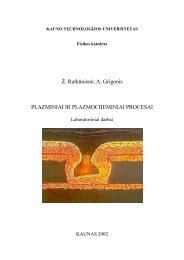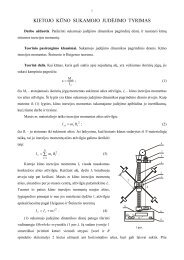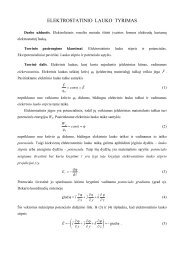PROCEEDINGS OF THE 7 INTERNATIONAL ... - Fizika
PROCEEDINGS OF THE 7 INTERNATIONAL ... - Fizika
PROCEEDINGS OF THE 7 INTERNATIONAL ... - Fizika
Create successful ePaper yourself
Turn your PDF publications into a flip-book with our unique Google optimized e-Paper software.
MEDICAL PHYSICS IN <strong>THE</strong> BALTIC STATES 7 (2009)<br />
Proceedings of International Conference “Medical Physics 2009”<br />
8 - 10 October 2009, Kaunas, Lithuania<br />
HEALTH PHYSICS ASPECTS <strong>OF</strong> TRITIUM IN NUCLEAR SECTOR<br />
Irma GAJAUSKAITĖ*, Tatjana ZYK**, Gediminas ADLYS*, Edvardas KIELIUS*<br />
*Kaunas University of Technology, **Ignalina Nuclear Power Plant<br />
Abstract: Radiological effects of tritium are discussed, characterization of natural and manmade sources of tritium<br />
including nuclear sector is provided, dependence of tritium discharges upon reactor type is analyzed and tritium<br />
monitoring system in Ignalina NPP is presented in this article.<br />
Keywords: environmental radioactivity, tritium, nuclear reactors, RBMK reactor, liquid scintillation counter<br />
1. Introduction<br />
Tritium is a radioactive form of hydrogen, which is<br />
found naturally in air and water. Naturally occurring<br />
tritium is produced in the upper atmosphere by<br />
interaction of cosmic rays with the nuclei of the<br />
atmospheric gases, principally by induced reactions.<br />
Maximum contribution has the interaction between a<br />
fast neutron and atmospheric nitrogen. Products of this<br />
reaction are tritium and carbon:<br />
14 1 3 12<br />
7 N + 0n<br />
→ 1H<br />
+ 6 C<br />
Very small fraction of natural tritium is produced by<br />
neutron capture by 6 Li in the earth’s crust [1].<br />
The third way is cosmic deuteron reaction with<br />
deuterium<br />
2 2 3 1<br />
1 H + 1 H → 1H<br />
+ 1p<br />
These are primarily interactions that happen in the upper<br />
atmosphere and the tritium falls to earth as rain.<br />
The man made tritium is released into environment by<br />
different sources.<br />
A large source was the stratosphere that accumulated<br />
tritium from the past thermonuclear testing [2]. Because<br />
of the atmospheric nuclear test conducted from 1945<br />
until 1963, natural levels of 3 H in environmental<br />
samples were enhanced. After stoppage of atmosphere<br />
nuclear weapon tests at 1963 the released activity of 3 H<br />
has decayed with a half-life of 12.33 year. At present,<br />
the level of tritium in the atmosphere is close to natural<br />
origin before the nuclear tests [3].<br />
The main source of the released tritium to-day are<br />
nuclear reactors and uranium fuel reprocessing plants.<br />
Other possible sources include consumer products and<br />
medical wastes [2].<br />
New tritium sources are research units for nuclear<br />
fusion and neutrons generation.<br />
At present, natural tritium production remains far higher<br />
than manmade sources.<br />
2. Radiological effects of tritium<br />
The tritium nucleus has extra neutrons, deficit in<br />
protons and excess amount of energy to be stable.<br />
100<br />
Because of this phenomenon the nucleus 3 H will<br />
undergo a nuclear transformation (radioactive decay)<br />
and one neutron converts to proton. This reduces the<br />
energy in the nucleus and new helium nucleus is left<br />
more stable. During transformation tritium nucleus<br />
emits a beta minus particle and antineutrino.<br />
3<br />
1<br />
−<br />
H → He + β +<br />
~ ν<br />
3<br />
2<br />
The antineutrino ν ~ has no biological significance<br />
because it practically does not interact with matter.<br />
The maximum energy of emitted beta particle is of 18,6<br />
keV with an average energy is of 5,7 keV. This is low<br />
energy beta radiation compared to most naturally<br />
occurring radioactive beta emitters. It is considered that<br />
relative biological effectiveness (RBE) of tritium is the<br />
same as of standard X-ray or gamma radiation. In this<br />
case, radiation weighting factor equal to 1 is applied to<br />
all Low Energy Transfer radiation (LET). The<br />
justification is that in general the greater values my not<br />
apply to cancer induction in humans (ICRP, 2007).<br />
Tritium is pure beta emitter of low energy. The<br />
maximum energy of 18,6 keV corresponds to maximum<br />
range of 6 μm in water or biological tissue. For<br />
comparison, the thickness of the epidermis and dermis<br />
of human skin is 20-100 μm and 1-3 mm respectively<br />
[1]. So the outer layer of skin is enough to stop external<br />
beta radiation of tritium. For this reason tritium could<br />
produce most internal exposure if it is taken into the<br />
body. It can happene by two main ways: inhalation and<br />
ingestion. The three major forms of tritium are present<br />
in the environment: tritiated water vapor (HTO),<br />
molecular tritium (HT) and tritiated methane (CH3T)<br />
[4]. These can be incorporated as a tissue free-water<br />
tritium into living organisms as organically bound<br />
tritium (OBT).<br />
Organically bound tritium has longer retention time in<br />
body than tritiated water. In the case of tritiated water<br />
tritium is expelled with a biological half life of<br />
approximately 10 days. For organic tritium inside the<br />
body the half life is approximately 30 days [1].








